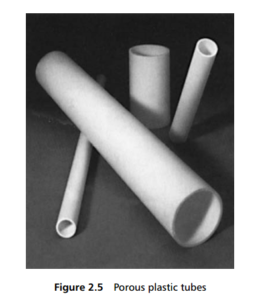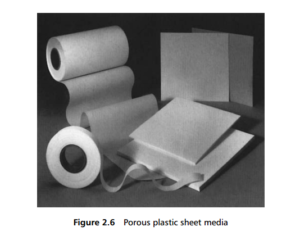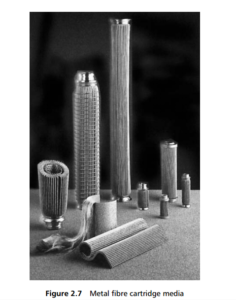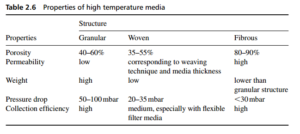0
-
An empty cart
You have no item in your shopping cart
As already mentioned, a major feature of the inorganic materials included here is their ability to operate at high temperatures. The importance of this particular set of applications is continually growing.


Classed under this heading are media made from metal powder and fibres, ceramic powder and mineral wools, glass powder and carbon fibres (used for their mechanical separation ability, not as adsorbent).
Metal media are mostly supplied in sintered form, since any materials that escape from the medium would be quite harmful downstream. Sintered metal fibres have a very high porosity, a low resistance to flow and a high dirt-holding capacity. The
fibres are long with controlled diameters ranging from 1–30 um. Some typical metal fibre elements are shown in Figure 2.7. Sintered metal media are used extensively for polymer applications, especially central polymer filter and spinback applications, where they provide for increased on-stream life. Other applications using high grade alloys include the chemical and process industries as well as applications in nuclear containment venting and nuclear waste streams. The mechanical strength of sintered metal media is around double that of typical powder based media or ceramics or
glass fibres. Non-graded sintered metal fibre is commonly used in corrugated or pleated form for the filtration of low viscosity fluids such as hydraulic oils and fuels.

Ceramic filter elements have a particular application for higher fluid temperatures and for handling corrosive fluids. Elements made from vitreous bonded refractory ceramic aggregate also have a high resistance to physical and thermal shock. Ceramic elements can be cast or moulded in various element forms with varying degrees of porosity and uniformity of structure. Void volumes are typically up to 50%. Microporous types can be produced with pore sizes down to 1 um. Ceramic elements can be used for filtering both air and liquids. They are particularly suitable for use with acids and alkalis. Properties of media for use with higher temperature fluids are shown in Table 2.6 .

Mineral wools can also be regarded as a ceramic material. They are rather like natural felts, with random fibre distribution in three dimensions, offering a tortuous path for filtration in depth. Their densities are low, permeability is high and with suitable packing very fine filtration can be achieved with minimum pressure drop. It is often necessary, however, that flow velocities be kept very low in order to avoid bunching of the fibres, with a consequent drop in efficiency. This somewhat limits their application with liquid filtration, although they are widely used for pure air filtration and the removal of solid particles from gases. In the latter respect mineral fibres may be used at working temperatures well above those possible with other non-metallic filters, for example at temperatures of 500°C or even higher for short periods.
Performance down to sub-micrometre size is possible with mineral wool filter pads. In the case of ultra-fine gas or air filtration, a nominal optimum velocity for flow rate is 10 m/min decreasing to 5 m/min at a working temperature of 150°C.
Flow velocities in excess of 15m/min will normally promote bunching, but velocities as high as 40 m/min per minute may be accommodated where some loss of filtration efficiency can be tolerated. Typically, a very fine fibre filter pad of 12.5mm
thickness should be capable of removing solid particles from gases down to 0.1 um at gas velocities of the order of 10m/min through the pad, with only nominal resistance. Increasing the filter pad thickness above an optimum does not necessarily
increase filtration efficiency, although it increases the possibility of trapping still finer particles. Thus, for sterile air and similar applications, the filter pad thickness may be as great as 100 to 125mm.When used for ultra-fine and sub-micrometre filtration in this way, it is also desirable that the air be prefiltered to remove coarser particles, leaving the pad itself to deal with the finer contaminants. This will increase the life of the filter pad, which may then be as high as three to six months under continuous use.
Glass fibres in blanket or pad form are widely used as a primary stage air filter. By modification of the conventional spinning process, the blanket as manufactured can have progressively increasing density from one side to the other, e.g. sparsely packed large diameter fibres on the dirty air side, gradually giving way to more densely packed small diameter fibres towards the inner surface. This effect is produced by an ageing process, which conditions the blanket, followed by a further operation to expand the fibres. Expansion produces an aerated filter medium of greatly increased volume and thus high porosity. Binders added prior to this stage can act as fibre lubricants to assist expansion. The expanded blanket can then be oven-treated to cure the binder and cement the fibres together to produce a rigid, light weight mass.
Medium and fine glass filter pads are produced from a blend of glass fibre strands and glass microfibres bonded together with a binder to form thin sheets. A typical filter medium pad is then constructed by interleaving a continuous length of glassfi bre medium, concertina-folded over wire mesh or perforated aluminium separators. Ultra-fine filters such as HEPA and ULPA elements use a sheet form of medium produced only with glass microfibres. The complete element may be constructed as previously described, interleaved with spacers cut from microglass paper.
Synthetic filter media such as the meltblown and spunbonded polymeric materials are beginning to be used more frequently in place of glass fibres.
Commercial carbon fibre is produced in fibre diameters of the order of 5–10 um from a variety of starting materials such as acrylic textile fibres, cellulose-based fibres or even pitch. They offer a possible alternative to organic fibres and glass
fibres for filter pads and felts for extreme chemical and temperature uses, with the additional advantage that the material can be activated and is thus able also to perform as an adsorbent filter. The main limitation of carbon fibre as a filter medium has been its expense, coupled with the fact that the current fibre diameter sizes available mean that they cannot achieve the performance of current HEPA filters using microglass fibres. However, carbon fibres down to nanometre diameters are now becoming commercially available and these are going to be an exceedingly important component of the fibre filter media business.
For further information, please click here.